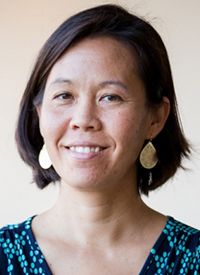PARP Inhibition Improves PFS as Frontline Maintenance in Ovarian Cancer, OS Data Awaited
Lan G. Coffman, MD, PhD, discusses pivotal trials evaluating frontline maintenance therapy in advanced ovarian cancer and unanswered questions that still need to be addressed with future research.
Lan G. Coffman, MD, PhD, assistant professor at the University of Pittsburgh Medical Center Hillman Cancer Center

Lan G. Coffman, MD, PhD
Frontline maintenance PARP inhibition has led to impressive progression-free survival (PFS) benefit in patients with advanced ovarian cancer, said Lan G. Coffman, MD, PhD, but the hope is that treatment with these agents will also translate to an extension in overall survival (OS).
“Everyone should be aware that maintenance PARP inhibition is approved and available for use—especially in our patients with BRCA mutations, both germline and somatic,” stressed Coffman. “There are impressive PFS data, but we don't have OS data yet. It’s an option; it's something to discuss with our patients, but we can't yet say, ‘Yes, this is going to make you live longer.’”
In an interview during the 2019 OncLive® State of the Science Summit™ on Ovarian Center, Coffman, assistant professor at the University of Pittsburgh Medical Center Hillman Cancer Center, discussed pivotal trials evaluating frontline maintenance therapy in advanced disease and unanswered questions that still need to be addressed with future research.
OncLive: What data have we seen with olaparib (Lynparza) in the phase III SOLO-1 trial?
Coffman: This is the trial that is the most mature; we actually have published data on it. It's exploring the use of olaparib in the maintenance setting in women who have had either a partial or complete response to initial surgical debulking followed by platinum-based chemotherapy. It’s a fairly transformative study; the results have been very significant thus far.
We mainly have PFS data, but olaparib prolonged PFS by up to 3 years in these women, which is impressive and blows away other maintenance trials that have been done in this setting thus far. The major question that remains is, “Is this going to translate into survival benefit?” The data are just not mature yet.
The phase III PRIMA trial examining niraparib (Zejula) was reported to have met its primary endpoint. Could you speak to that research?
We don't have published data yet. There was a press release saying that PRIMA met its primary endpoint, which was PFS; however, we don't actually have numbers there. The main difference between PRIMA and SOLO-1 is that [PRIMA is] taking all-comers; it’s not restricted to patients with BRCA-mutated disease like SOLO-1 was. They are using homologous recombination deficiency (HRD) as a biomarker, but the press release said that there was a PFS advantage regardless of biomarker status. The questions will be, “How significant is that PFS advantage, and what's the difference in HRD-positive versus HRD-negative tumors?” We would have all expected at least some PFS benefit. We'll have to see when these data actually get published.
What are some other key trials being done in this space?
They kind of take on a similar theme. There’s a trial with veliparib, the GOG-3005 trial, which is interesting in that it's actually using veliparib in combination with platinum-based therapy and then as maintenance therapy; this is similar to how bevacizumab (Avastin) was studied. There are 3 arms in that trial: chemotherapy alone, chemotherapy plus veliparib followed by placebo maintenance, and then chemotherapy plus veliparib and veliparib maintenance. There are similar endpoints in terms of PFS. This trial is also looking at all-comers, but breaks down responses based on BRCA mutation status. It will be interesting to see if adding a PARP inhibitor to cytotoxic chemotherapy will deepen the response and what the toxicity of that [approach] will be. We're all concerned about myelosuppression.
Then the second olaparib trial, PAOLA-1, is looking at adding olaparib to bevacizumab as frontline maintenance therapy. Previous studies, such as GOG-218 and ICON7, looked at bevacizumab as upfront maintenance, [which showed] modest [improvement in] PFS. Now, this trial is really looking at [answering the question, “What if we give both of them together? Can we keep [increasing] that PFS benefit and hopefully move into an OS benefit?”
[These trials are] all take on a similar theme, but are exploring ways in which we can make this maintenance procedure more effective.
Could you expand on any safety concerns with these approaches?
The main concern, especially with cytotoxic chemotherapy and PARP inhibitors together is that you’re going to significantly increase myelosuppression. Can patients actually get through the chemotherapy—which we know has OS benefit—and are they going to have meaningful responses to that combination? There’s also the concern of increasing risk of leukemic transformation, as you're inducing more DNA damage systemically. We'll see [what the turnout is], but there is definitely concern there.
What other agents are under investigation in this setting that you wanted to highlight?
One of the main ones is bevacizumab, for which the data are a little bit older and more mature. The data largely show a PFS benefit and maybe a modest OS benefit in a high-risk population. PARP inhibitors have really come in as the other maintenance therapy. There are other clinical trials exploring immunotherapy, as well as CDK4/6 inhibitors as maintenance; this is being done more in the recurrent setting because it's easier to study [these approaches] there first. However, in terms of large phase III trials, these are the majority of the agents being studied.
What are the key challenges that are still faced in the maintenance setting?
What we have to determine in terms of OS benefit. The PFS is fantastic, along with a reasonable toxicity profile, but there is the concern that we're not actually curing women—that we're just giving them second-line therapy early. If we're doing that, why are we doing that? If [our efforts aren’t] going to impact survival, we can use that when the disease comes back and continue to gain benefit. I believe that OS piece [of the puzzle] is what we're all waiting for.



